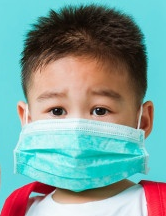Talk about the efficacy of face masks is reverberating throughout the country right now, mostly talk about how well various materials filter out viral particles.
I’d like to offer a different argument for face masks, one not used nearly often enough in official conversations: Masks keep hands away from noses, lips, and mouths. I was out with a nurse friend in a bakery awhile back* when she pointed out to me that I was using my hands as I talked and putting them on or near my face.
“Don’t do that!” she said fiercely. “Not now. Not with COVID.”
I frequently do “that,” however — and so do many other teachers I know. Teachers often talk with their hands. Those flourishes in front of the whiteboard come naturally after awhile. A more vivacious, animated teacher has an easier time holding her classes’ attention. I point. I wave my arms. And I also crook my index finger and rub my lips while I think. Sometimes I stroke my chin while making a decision.
What I have realized and want to share is that I stop those unsafe behaviors when my mask is on. When my face is covered, my hands don’t go near my face. With my mouth and nose inaccessible, my hands find other things to do.
This change in a lifetime of natural behavior strikes me as an argument for finding the most comfortable, effective mask(s) possible and keeping them on throughout the day. I would suggest any readers who are face-touchers especially should stay inside their masks until they leave work, except for lunch and other necessary breaks. Even if the class has gone to gym or art, germs are still in the air and may be on surfaces. While you are working alone, it’s worth thinking about air flow in small, converted closet spaces. So many schools have converted closets and storage rooms into active work areas. Copy machines and laminators turn up in the strangest of places. Any ventilation and maybe cleaning in repurposed spaces will likely be haphazard at best.
Comfort is key here. Comfort is also extremely individual, while masks are unfortunately mass-produced. Because of the lack of careful sizing, we can expect to see many a slip ‘twixt the cup and the lip in our masks.

That’s part of our problem in classrooms. A mask that fits an adolescent doesn’t fit a kindergartener. Even with mask mandates, certain adults and children are running around in face coverings that are more theoretical than real.
Below is an example of a tip I got from an MD friend. She staples her masks to make them shorter along the side. This prevents gapping for shorter-faced persons. This mask has a wire so I can fit it to my nose. It covers my whole lower face and chin easily. Longer face persons may need to discard or share a few masks within the family, those masks that simply don’t cover enough face.

Eduhonesty: This post was inspired by my habit of stripping off that mask as soon as I am out of a crowd or store, along with a family habit of automatically putting hands on faces throughout the day. Especially before Delta took off, many of us were becoming casual about masks. I wasn’t paying enough attention while eating my croissant at that bakery table. It’s easy to fall back into old habits while in conversation or contemplation. So I thought I’d share this cautionary note about keeping masks on until the school day has actually ended.
*My RN friend won’t sit inside that bakery now. The Delta strain has pushed her back to taking outdoor walks and using double masks.
